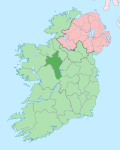This article needs additional citations for verification .(October 2016) |
Cortober Corr an Tobair | |
|---|---|
Townland | |
 The junction of the N4 and R368 roads is in Cortober | |
| Coordinates: 53°56′17″N8°06′04″W / 53.938°N 8.101°W | |
| Country | Ireland |
| Province | Connacht |
| County | County Roscommon |
| Population (2011) [1] | |
• Total | 465 |
| Time zone | UTC+0 (WET) |
| • Summer (DST) | UTC-1 (IST (WEST)) |
| Irish Grid Reference | M941997 |
Cortober (Irish : Corr an Tobair, meaning 'round hill of the spring well') [2] is a village and townland in County Roscommon, Ireland. It is located across the bridge from the town of Carrick-on-Shannon on the right bank of the River Shannon. It is bounded on the north by the parish of Tumna and River Shannon, on the east by the River Shannon, on the south by the townland of Cordrehead and Killukin and on the west by Mullaghmore. Although Cortober is its own separate village, it is usually grouped as part of Carrick-on-Shannon because it is almost adjacent. [3] The N4 passes through the northern part of Cortober. From it, the R368 branches off towards the southwest.

